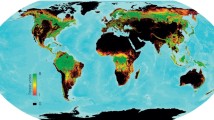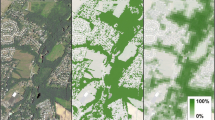Abstract
Satellite-based remote sensing offers great potential for frequent assessment of forest cover over broad spatial scales, however, calibration and validation using ground-based surveys are needed. In this study, forest cover estimates for the United States from a recently developed land surface cover map generated from satellite remote sensing data were compared to state-level inventory data from the U.S. National Resources Planning Act Timber Database. The land cover map was produced at the U.S. Geological Survey EROS Data Center and is based on imagery from the AVHRR sensor (spatial resolution ∼1.1 km). Vegetation type was classified using the temporal signal in the Normalized Difference Vegetation Index derived from AVHRR data. Comparisons revealed close agreement in the estimate of forest cover for extensively forested states with large polygons of relatively similar vegetation such as Oregon. Larger forest cover differences were observed in other states with some regional patterns in the level of agreement apparent.
Comparisons in inventory- and remote sensing-based estimates of current forested area with potential vegetation maps indicated the magnitude of past land use change and the potential for future changes. The remote sensing approach appears to hold promise for conducting surveys of forest cover where inventory data are limited or where rates of vegetation change, due to human or climatic factors, are rapid.
Similar content being viewed by others
References
Box, E.O., Holben, B.N., and Kalb, V.: 1989. ‘Accuracy of the AVHRR Vegetation Index as a Predictor of Biomass, Primary Productivity and Net CO2 Flux’, Vegetatio 80, 71–89.
Curran, P.J.: 1983, ‘Multispectral Remote Sensing for the Estimation of Green Leaf Area Index’, Phil. Trans. R. Soc. Lond. A 309, 257–270.
Eyre, F.H. (Ed.): 1980, Forest Cover Types of the United States and Canada, Soc. Amer. Foresters, Washington, DC., 148 pp.
Gedney, D.R., Bassett, P.M., and Mei, M.A.: 1986, Timber Resource Statistics for Non-Federal Forest Land in Southwest Oregon, USDA Forest Service Resource Bulletin PNW-138, Portland, Or, 26 pp.
Goward, S.M., Markham, B., Dye, D.G., Dulaney, W., and Yang, J.: 1991, ‘Normalized Difference Vegetation Index Measurements from the Advanced Very High Resolution Radiometer’, Remote Sens. Environ. 35, 257–277.
Houghton, R.A., Hobbie, J.E., Melillo, J.M., Moore, B., Peterson, B.J., Shaver, G.R., and Woodwell, G.M.: 1983, ‘Changes in the Carbon Content of Terrestrial Biota and Soils between 1860 and 1980: Net Releases of CO2 to the Atmosphere’, Ecol. Monog. 53, 235–263.
Houghton, R.A.: 1991, ‘Tropical Deforestation and Atmospheric Carbon Dioxide’, Clim. Change 19, 99–118.
Iverson, L.R., Cook, E.A., and Graham, R.L.: 1989a, ‘A Technique for Extrapolating and Validating Forest Cover across Large Regions: Calibrating AVHRR Data with TM Data’, Int. J. Remote Sensing 10, 1805–1812.
Iverson, L.R., Graham, R.L., and Cook, E.A.: 1989b, ‘Applications of Satellite Remote Sensing to Forested Ecosystems’, Lands. Ecol. 3, 131–143.
Küchler, A.W.: 1964, Potential Natural Vegetation of the Conterminous United States, Amer. Geogr. Soc., Spec. Publ. 36, 110 pp.
Lashof, D.A.: 1989, ‘The Dynamic Greenhouse: Feedback Processes That May Influence Future Concentrations of Atmospheric Trace Gases and Climate Change’, Clim. Change 14, 213–242.
Loveland, T.R., Merchant, J.W., Ohlen, D.O., and Brown, J.F.: 1991, ‘Development of a Land-Cover Characteristics Database for the Conterminous U.S.’, Photogram. Eng. Rem. Sens. 57, 1453–1463.
McLellan, T.M., Martin, M.E., Aber, J.D., Melillo, J.M., Nadelhoffer, K.J., and Dewey, B.: 1991, ‘Comparison of Wet Chemistry and Near Infrared Reflectance Measurements of Carbon-Fraction Chemistry and Nitrogen Concentration of Forest Foliage’, Can. J. For. Res. 21, 1689–1693.
Myers, N.: 1991, ‘Tropical Forests: Present Status and Future Outlook’, Clim. Change 19, 3–32.
Post, W.M., Peng, T.-H., Emanuel, W.R., King, A.W., Dale, V.H., and DeAngelis, D.L.: 1990, ‘The Global Carbon Cycle’, Am. Scientist 78, 310–326.
Tepley, J., and Green, K.: 1991, ‘Old Growth Forest — How Much Remains?’, Geog. Info. Syst. 1, 31–32.
Townshend, J.R.G., and Justice, C.O.: 1988, ‘Selecting the Spatial Resolution of Satellite Sensors Required for Global Monitoring of Land Transformations’, Int. J. Remote Sensing 9, 187–236.
Townshend, J., Justice, C., Li, W., Gurney, C., and McManus, J.: 1991, ‘Global Land Cover Classification by Remote Sensing: Present Capabilities and Future Possibilities’, Remote Sens. Environ. 35, 243–255.
Tucker, C.J., Townshend, J.R.G., and Goff, T.E.: 1985, ‘African Land-Cover Classification Using Satellite Data’, Science 227, 369–375.
Tucker, C.J., Townshend, J.R.G., Goff, T.E., and Holben, B.N.: 1986, ‘Continental and Global Scale Remote Sensing of Land Cover’, In: Trabalka, J.R. and Reichle, D.E. (Eds.) The Changing Carbon Cycle: A Global Analysis, Springer-Verlag, New York, pp. 221–241.
Waddell, K.L., Oswald, D.D., Powell, D.S.: 1989, Forest Statistics of the United States, USDA Forest Service Res. Bull., PNW-RB-168, 106 pp.
Wessman, C.A., Aber, J.D., Peterson, D.L., and Melillo, J.M.: 1988, ‘Remote Sensing of Canopy Chemistry and Nitrogen Cycling in Temperate Forest Ecosystems’, Nature 335, 154–156.
Williams, M.: 1988, ‘The Death and Rebirth of the American Forest: Clearing and Reversion in the United States, 1900–1980’, In Richards, J.F. and Tucker, R.P. (Eds.) World Deforestation in the Twentieth Century, Duke University Press, Durham, NC.
World Resources Institute (WRI): 1990, World Resources 1990–91, Oxford University Press, Oxford, 383 pp.
Author information
Authors and Affiliations
Rights and permissions
About this article
Cite this article
Turner, D.P., Koerper, G., Gucinski, H. et al. Monitoring global change: Comparison of forest cover estimates using remote sensing and inventory approaches. Environ Monit Assess 26, 295–305 (1993). https://doi.org/10.1007/BF00547506
Received:
Issue Date:
DOI: https://doi.org/10.1007/BF00547506




